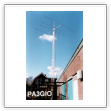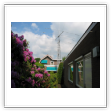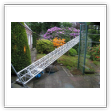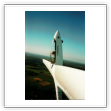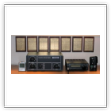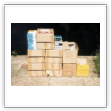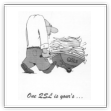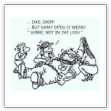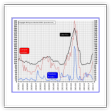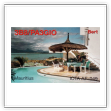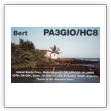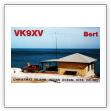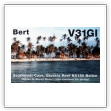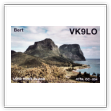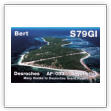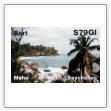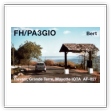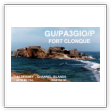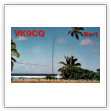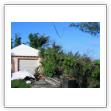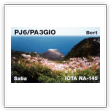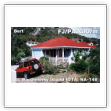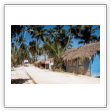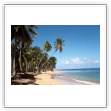PA3GIO
Bert Van Den Berg
Parklaan 38
3931 Woudenberg
KK - NETHERLAND
email : pa3gio
web : pa3gio.nl
Who does not know Bert ? hands up, very friendly man, very experienced in DX expeditions, very good DX operator, he gave me many new ones, is a pleasure listening him during heavy pileup, learning the way he handle the pileup, always kind and correct, "a gentleman", what else to say " many thanks Bert "
Here some pictures about Bert PA3GIO.
Here some pictures about Bert PA3GIO' s DX Expeditions.
THE DECEMBER 2003 CQ DL INTERVIEW
(This is the Original longer version in English)
With thanks to CQ DL, Stefan Hüpper, DH5FFL and Interviewer Ric, DL2VFR.
It's amazing what can be achieved by only one man
ACTIVE SOLO DX-peditioner
It's not easy to get a interview with Bert van den Berg, PA3GIO.
He's either on a DX-pedition - or at home, busy with the QSLs.
No wonder, for someone who received the 2002 IOTA Merit Award.
Bert, how long have you been on the DX and IOTA tour?
It started with me working /P and /M from Dartmoor in SW England in the summer of 1993. By the way, there is a nice story about Marconi while he was on Dartmoor - and what he told a friend after his experiments there. "After the first signals came in, the calm in my life ended."
Then in May 1994 I was with my jeep on the beaches of the island of Rhodes, where I also got to know the local amateur radio club. `Bill', SV5AZP was my guide. I also visited Vasilles, SV5TS, at his home - and while I was in his garden I asked if he had any garden plans. "Growing orange trees and antennas!" was his reply. And Nikos, SV5TH, at his work QTH, told me that "working pile-ups is like top-class sport"! In Lardos we met SV5BOP; I also worked a few other locals from the beaches, but did not meet up with them in person. After going QRT on the beach, I disconnected the power cable from the car battery. This was followed by a brief moment of panic when the jeep refused to start, but this simply turned out to be a dirty contact in the starter connector! My last visit was to the home of SV5BYP. All in all I can look back at a wonderful time with some very friendly people. It seems that I'm still not forgotten there.
When did you get your licence and what is your profession?
I've been interested in radio since I was 8 years old. It was also obvious that it would be my profession.
I started building equipment when I was about 10: a very simple Morse key with battery and lamp connected with wires to the next room so I could have a few QSOs with a friend! Then it was a one-valve radio, on which I heard 13 broadcast stations. Maybe I would hear a few more with increased sensitivity - and yes, eventually these `improvements' resulted in a `transmitter'. My dear neighbour, who owned an AR88D, discovered that I was the one with the `transmitter', but he didn't have a problem with it!
After moving to a different city a new neighbour was PAØCV. He let me do my first SWL sessions on his BC312. Very nice! My old neighbour then visited us and gave me a beautiful present: a short-wave receiver he had made for me, which also had 80m on it. Soon after that, in 1962, I joined VERON [the Dutch national society] and became an SWL. In the years that followed I enjoyed constantly improving the receiver and rebuilding it with the latest ideas published in Electron. Around this time SSB technology was becoming increasingly popular. Later I also inherited my old neighbour's AR88D, which was used for communication between Indonesia and the Netherlands - and which I still own.
It was nice to hear all the DX - also on 80m late at night and in the early hours of the morning - and sending and receiving QSL cards via the Bureau. At this time I was studying electronics.
I got my VHF licence in 1968, but I was only interested in shortwave amateur radio, so I didn't apply for a VHF call. By this time I had become an electronics engineer. For the first few years my job was research in a (US-owned) laboratory for VHF/UHF TV tuners, where they had a lot of beautiful measuring equipment. Then, after another move, came a period without amateur radio.
Then a very sad event in my family changed my philosophy of life and so some years later I decided to retire from my job. After some very busy years I decided that it was finally time to get my HF licence. I bought a computer to practise CW using Morse Academy, which worked very well indeed. Six months later, in 1993, I got my full HF licence. I will never forget that day.
How many islands or DXCC entities have you activated so far?
I'd have to count them all up, but it must be 62 DX-peditions - that's 28 DXCC-type ones and 37 IOTAs.
What's so fascinating for you about going on a DX-pedition?
Firstly, I always loved being able to operate outside in the fresh air. Operating outside, especially in beautiful locations, is so much better than staring at the walls inside a hotel room.
In the 1960s I went along to the local field days in Rotterdam. I was also inspired by a VERON evening in Rotterdam with Jan, PAØSSB, demonstrating how easily he could make QSOs with his home-made transceiver and helically wound vertical, called a `Joystick'.
In 1993 I decided that the ideal style for me was to operate from a car from different locations. By chance Kenwood then came on the market with the TS-50S - an excellent, small 100W transceiver. In 1993-94 the propagation was good enough to work the USA from my car from southern England. In fact they thought I was a county chaser!
While I was in Jersey in 1995 someone told me to go to 20m, 14.260 MHz. I thought it wouldn't be worth it from Jersey, but after QSY-ing I realised he was right; it was indeed interesting to get some more callers. The conditions weren't too good and I had propagation to Japan on one day only, but this was just the beginning. The propagation got better and better - and then slowly you realise, when the propagation is very good, what you can do with a simple set-up: a small 100W radio. And don't underestimate the simple multiband doublet antenna for its efficiency, DX capability and wide coverage. Even a helically wound mobile antenna (like the `Joystick') can do the job.
In 1999 I decided to go to the Caribbean and Central America for a more interesting DXCC and IOTA experience. I got lots of callers, which was really amazing! I operated /M from Sint Maarten, PJ8/FS - also /P from Tintamarre, NA-199, with a car battery dropped by a small boat. Then back via Miami to Belize and Glover's Reef, NA-180, Glovers Reef, with many a pile-up there too. Jokingly Horst, DK3GG, asked me, "Which countries are you not visiting?". I laughed and said, "We shall see!".
It helps a lot to choose an island, or a QTH close to the sea. You get more gain. In fact it's almost as if you're running 400W or using a beam. I love islands anyway. It's fascinating to listen to the band opening up, just like sunrise. The best thing for me was to be able to make contact with PAØ, such as with my friend Hans, PA3DGH. And all this with a simple antenna - a wire or a vertical - and 100W. Also fascinating are all the different voices and accents. Sometimes I recognise only the voice at first, but then the callsign springs to mind and I can reply with that. That's fun, of course. You also get to know lots of amateurs and after a while they get know me too. Indeed with some of them I've had tens or even hundreds of QSOs. That's really great. They know that I'll be there for hours and hours - and won't give up until I've worked them all. Often I'll keep going until the band closes, with little or no time to have something to eat or drink. It really is important to keep the rhythm going all the time. The only time I do stop is for an hour or so for dinner. It's only a pity that this is normally a time when the propagation is good, but I need that break so I can relax a bit. I sleep very well after the band has closed, or there are simply no more callers. It's a great feeling to know that you gave everything you could.
What's the most exciting place you've been to?
That's difficult to say; I have special memories of so many of them. To name but a few, Rhodes, as I said before, and the beautiful Luttrell's Tower in Southern England, a QTH which was used by Marconi. Fort Clonque, Alderney, which is surrounded by the sea at high tide; uninhabited Islands like Longstone (Farne), sitting on a rock in a small dry area, with the tide coming in next to a historic lighthouse (Grace Darling). That was very exciting, but trips like this are very dependent on the weather.
There again, in 1999, my first time in Belize, Central America. It was very hot, but it's amazing how a warm and very strong (even gale-force) wind can make it very pleasant. Every year these low-lying islands are especially vulnerable during the hurricane season. It was exciting to be one of the first visitors to go to Glovers Reef after Hurricane Mitch, which hit the area the previous year. This entailed a three-hour speedboat trip at full throttle, navigating between all the sandbanks just below the surface and arriving at around sunset. It was marvellous to see that small paradise island with its white sands and waving palms coming into view in the twilight hours. It was just like a dream.
On introducing myself to the manager, he said that I must be the radio amateur - and assured me that they would help me with my antenna the next morning. "We have good tree climbers!" he added. They where all busy rebuilding their restaurant next to the lagoon, which had completely vanished in the hurricane. The next day his young `tree climber' had no problems climbing up to a height of 40' or so. At which point the manager asked me how much higher he needed to go. "That'll do," I said. It was really frightening to see the young lad up there!
Then came Blackbird Caye in the Turneffe Islands, NA-123, where the rather aggressive local insects (they call them `doctor flies') hit me real hard!
We then moved on to Placencia, in southern Belize, and Little Water Caye, NA-180, 18 miles SE of Punta Placencia. A lot of sand flies here. This island was even smaller and very charming, with the sound of the waves beneath the wooden Santa Maria cabin - and the pelicans in front. This island is even more remote; in fact only on one occasion did I see a boat pass by. Then on 1 July 2001 the German owner closed down the island accommodation and moved to San Ignacio on the Belize mainland, having put the island on the market. Then in October 2001 came Hurricane Iris, which reportedly destroyed a lot of the Placencia area. The Glovers Reef Resort sustained significant damage too, with Little Water Caye losing all of its buildings. According to a recent report it has now been purchased by the Friends of Nature, a Belizean non-governmental organisation. The minority share of the island will stay in the hands of a private owner who has agreed to stop the development of Little Water Caye and to create a new marine conservation area in southern Belize, which will help to protect the only place in the world where you're almost certain to see large numbers of whale shark, the largest fish on earth. This sizeable marine conservation area includes the waters surrounding Little Water Caye. The island will house a marine research station and ranger headquarters and also serve as the management centre for surrounding marine conservation areas, including the nearby Gladden Spit Marine Reserve and Laughing Bird Caye World Heritage Site.
Later in 1999 we went to another very remote island: Desroches in the Indian Ocean, 250 kms south of Mahé in the Amirante group (Seychelles). Here, a man climbed our tree so easily. In fact they told me he'd been born in a tree! It was also amazing that you could eat so very well in such a remote place (please don't remind me of the cost, though!).
Then in 2000 the Galapagos Islands, with sea iguanas literally on the doorstep of the bungalow, where it was very hot. The worst thing here was that I had to put up with 12 days of local power line noise, on 21 MHz up to S7 in my headphones!
And later that year the islands of Mafia & Pemba, Tanzania. Exciting flights here. Indeed when we left Dar Es Salaam after the heavy rain, they weren't even sure whether the plane would be able to land in Mafia. There are no telephones and they only have a HF link, a TS-50 at Dar Es Salaam airport. And before we took off the pilot announced he would have to inspect the island `runway' from the air; if it was not safe, we would have to fly all the way back to Dar Es Salaam. In Mafia I then had to tell the manager what the best time would be to contact the airport in Dar Es Salaam on the mainland. Then the small Cessna, from Mafia to Pemba, just the two of us and the pilot, crammed together with our luggage. I was squashed against the dashboard, with the fuel gauges getting lower and lower. At Pemba they read `empty'. The pilot did not refuel the plane at Pemba, but confirmed that he was going on to Dar Es Salaam. I asked him about the fuel gauges. He laughed and said, "Never mind those, they're unreliable. I simply work it out on the basis my flying hours!" OK, I thought, at least we'd survived.
After that came an even more exciting and very fast two- hour taxi ride in Pemba. It would seem that in Pemba a motorist `owns' the road; any pedestrians or cyclists have to make sure they get out of the way in time - or, in other words, jump for their lives! Another interesting experience was at night, when a group of chanting bushbabies suddenly ran through our room.
This was because the front wall of this room was completely missing, although during the day it did have the advantage of opening out onto views of the lagoon.
Bushbabies are primitive primates related to the lemurs of Madagascar. They announce their presence by a loud, croaking wail, repeated at frequent intervals during the night. Its resemblance to the cry of a child is said to be the basis for the name `bushbaby'. In a restaurant this cute little fuzzy creature goes from table to table looking for fruit. Bushbabies are otherwise known as `galagos, or in Pemba `Garnett's Greater Bush Baby', Otolemur Garnettii. They are active at night and sleep during the day - in tree hollows, nests high up in the trees. They say airline earplugs protect you quite well against bushbaby chanting! I made some sound recordings of them.
The (diving) resort was in a very remote location, with no other developments within 50 kms. On arrival we found a fridge in our room, but when we tried turning on the light switch it soon became obvious that there was no electricity. The local people are very poor and have to walk for hours every day to collect drinking water. They had a generator running for just a few hours a day. They turn it off when they go to bed, and that is early. So as to extend my operation time I made arrangements for a car battery - and to collect extra fuel from the nearest village, on a motorcycle along a very poor `road'.
In 2001 I experienced an exciting flight to the island of Saba, in the Caribbean, with a runway which is only 400m long, one of the shortest in the world. Landing at St.-Barthélémy in 2002 was even more exciting.
There again, our arrival in Madagascar in 2001, warmly welcomed by a group of local amateurs; Solofo, 5R8ET, and Fidy, 5R8FV, were especially helpful. Also an interesting visit there to Radio Nederland, with all the open wire! Also, the direct charter flight and stay on Ile Sainte Marie, where they had a problem with the generator at night. I had to operate with a car battery - and oil lamp or torch for logging the QSOs on 80m! Then the very long journey by road to the airfield, in the south of Ile Sainte Marie, which was interrupted by a fallen tree - and the driver had to walk a long way for assistance!
Finally, our narrow escape from a cyclone in Niue on the day we left.
You prefer SSB. Can you tell us why?
It's not that I prefer SBB, but having just got my full licence I felt I didn't have much choice. For a DX-pedition you need a lot of experience. You also have to be very good at operating CW in practice, which is very different to doing the same thing at home!
What kind of equipment do you take with you and how much does it weigh?Do you ship anything in advance?
I don't ship anything in advance.
Travelling by air brings with it a few problems and which you have to try to avoid, especially damage to equipment and lost luggage. This means carrying as much as possible in your hand luggage. To avoid any disasters due to faulty equipment, you also have to take back-up equipment with you.
Travelling to small islands often means small planes, which means weight and size restrictions. This in turn means small-size equipment, which my XYL and I can carry in fairly compact backpacks. The weight here is 14 kg and 11 kg respectively - and in most cases they don't check the weight of hand luggage. As for the equipment itself: a Kenwood TS-50; PS-40 switch-mode power supply; an Annecke balanced tuner for 80 -10m; 2 x 20m lengths of wire for a doublet; 2 x 25m lengths of open wire feeder; Kenwood HS-5 headphones; some small, custom-made logbooks; a mini cassette recorder etc. As I really need to work with a mobile antenna, I take an Outbacker PerthPlus as a spare as well.
The equipment I can't take as hand luggage I check in as normal luggage: some 7 meter-long lightweight fishing rods, which are supports for the wire antenna, and the Outbacker Perth Mobile antenna.
Please note that I don't take a laptop. If I did that, I'd have to take another laptop with me as a back-up. I have to avoid problems with planes - and I prefer to take HF spares!
Is there any place where you tried to get a licence and it didn't work out?
Planning a DX-pedition and getting a licence means having sleepless nights! When I look back, many are easy to get, but waiting for them can be frustrating. In some places you really need the help of the local amateurs. In 1999 a case in point was Sint Maarten, in the Netherlands Antilles. They just had joined CEPT, but with the wrong prefix numbers. I had to make hurried arrangements with the very helpful local amateur club in Curaçao - and they arranged a PJ8 licence just in time. Shortly after my visit Curaçao then corrected the callsign prefix numbers, so CEPT was then OK for other amateurs.
Galapagos, HC8. I was waiting for my licence there when there was suddenly a local coup d'état. I had to arrange my flights at the very last moment.
Far more frustrating was Mauritius, 3B8. I applied in very good time. I phoned the licencing office down there a week before I was due to leave - and every day after that - but still nothing. In Mauritius I had to wait for another 3 days until the licence was ready. Having said that, I must count myself lucky, seeing as others had to wait on the island for one whole week. Even worse, groups from Germany and Belgium returned home without getting any licence at all.
How many QSL requests do you have to reply to per month or per year?
In recent years I have confirmed 33,000 to 44,000 QSOs per year.
Is there anything you'd like to tell the folks about QSL-ing?
I prefer to QSL via the Bureau, seeing as it's much less work for me than direct QSLs.
Please design your QSL in such a way that all the information is on one side. Make sure the `via Manager" line is large and very clear - and put that in the upper corner of the QSL. I've just received a 2 kg batch from Australia; all these cards where sent by mistake to one of my VK calls, and since the Bureau in Australia - as in the USA - does not send outgoing cards for free, this batch was sent to me direct at my request. Germany is the best QSL country. QSL work for me is very, very time consuming.
Although I like to see the QSL cards with their nice comments, it's faster and cheaper to send the QSO data via e-mail to QSL@pa3gio.nl. If you like, you can put your comments in my guestbook on my website at http://www.pa3gio.nl/. This would be very much appreciated.
What percentage of your expeditions is sponsored - or do you have to pay for everything?
All my DX-peditions have been funded solely by myself and my XYL.
Where would you like to go to in the future?
The next trip is to Bermuda, VP9. This was planned for September [2003], but then Hurricane Fabian struck. I did, though, manage to postpone it until November. It was another busy time with sleepless nights! [Update on PA3GIO/VP9, 9-18 November 2003: 5,800 QSO's in 10 days. Good propagation only on the last day but then with S6 local noise!, but nice on 80 and 40m with EU]
Who helps you in preparing for and carrying out your DX-peditions?
I do most of the planning myself. Of course I get plenty of inspiration from other DX-peditions. My friend PA3EKX also gave me a list of destinations which he thought I ought to aim for. Planning a DX-pedition requires a lot of research. It's also important to get in touch with an amateur who has done the same sort of thing. However, times change - so there's no guarantee that things will work out the same way. The QTH is extremely important. It's very difficult to choose a QTH without actually seeing it. Sometimes I have to ask non-amateurs about such things - and, they're not always able to give me the answers I need. My XYL is a great supporter. My friend Hans, PA3DGH, is unbelievable (604 QSOs…) and almost as busy as I am when he's monitoring my activities.
Would you like to join a team - or do you always prefer `One-man DX-peditioning'?
In my opinion a team has the considerable advantage of being able to go to rare and uninhabited islands and put up bigger antennas. So far I very much like the way I've done things: a single-operator DX-pedition has its charm, the advantage of simplicity, fewer problems; you can also get on the air straight away and save conference! Sometimes it amazes me what can be achieved.
What else do you like about amateur radio?
Lots of things, such as making friends all over the world. Their spontaneous reactions mean a lot to me. For example, Klaus, DK5WG, sent me a super present: a home-made plaque for my shack with a list of my DX-peditions on it. Juan, EA9IE, sent me a copy of his book, `DX y DX-istas'. After all the building of receivers in the past, I like the fascinating and never-ending subject of antennas.
What hobbies do you have besides amateur radio?
Well, amateur radio is a way of life, as they say - and currently I have very little time to spare. But besides amateur radio there are a lot of things I am interested in. In the past I've studied energy, history - also done plenty of gardening, walking, making 8mm movies, music, interior design etc.
When you think back, are there any interesting stories or anecdotes you can think of in connection with your expeditions?
There are so many. Perhaps I should write a book. Oh, there is this one: once I couldn't copy a Japanese callsign, so after a while the Japanese station said, "I give up". "No, no," I replied, "a radio amateur never gives up." And after that we made it!
Do you prefer any particular operating techniques? For example running a pile-up by numbers, asking for the last letter in the suffix, the full callsign - or a particular type of split-frequency operation?
This really is one of the top items.
Operating technique is extremely important and there's always a lot of discussion about the best way of doing it. I recommend the VKØIR Radio Operator's Manual by Peter Cassier, ON6TT, on the Cordell Expeditions website - or the planning documents for the Heard Island Expedition 1997 at http://www.cordell.org/htdocs/index.html. I'm not saying I agree with everything in it, but it's still interesting to read. It's the sole responsibility of the DX-peditioner to get things right - and a pile-up is only as good as the DX station's operating technique. It's a job, maybe even a game, but if you like the game then it's fun for everyone. If you don't like it, or lose your temper, it will be less fun. It's that simple. I don't see it as a holiday - forget it! It's really hard work, like top sport. I really love it, and I'm sure that helps to keep the audience happy.
With operating technique there's no such thing as good or bad. Take the controversial issue of the full callsign as opposed to the last two letters in the suffix. Full callsigns are fine if the DX station can copy them straight away - and of course this speeds things up. At the same time, though, it's obvious that in a huge pile-up the DX station can only copy the full callsigns of the stations with the strongest signals. More often than not the DX station will only be able to copy part of a callsign. Here it's more important for the audience and the DX station to listen with more intervals. Shorter transmissions can provide this.
As the years go by I learn these things - or I hope I learn them, of course. Callers must find out for themselves what the best method is. Every technique has its pros and cons. Simplex operation has the advantage of enabling you to constantly monitor the TX frequency and a lot of stations from various parts of the world, so you get less QRM creeping in from other QSOs. It's obvious that an audience which is waiting for a QSO will listen better, but eventually the DX station will have to find a way of splitting up the pile-up. Working by numbers can only be done up to a certain number of callers, but the best thing is that weaker stations get more of a chance to be heard. If the DX station is a fast operator, then every number gets a chance within a fairly short time. The stronger stations, of course, don't like this technique because what they want to do is simply `beat the pile-up' and not have to hang around waiting.
Split-frequency operation is needed if the DX station is weak and there's a huge number of stations in the pile-up. The stronger stations like this technique, of course, but I like to try and copy the very weak stations in between them as well - in fact I hold my breath until the QSO works out. Working Europe is like having a party. I really love it. Of course it's very important to have a clear listening frequency, but first and foremost it's extremely important to leave the DX frequencies and their `split windows' clear at all times for the sole use of DX-peditions. And should the `5 up' listening window be occupied, I solve the problem by choosing any clear frequency in the band. This seems to work well - except in the case of amateurs whose transceivers cannot handle this. Indeed, a few times I've worked stations who've said "Wait…" because they've had to tune their dials!
I have made lots of tape recordings and find them very useful to listen to. And when I get older I can play them again, close my eyes and think, "Yes, what fun that was!"
Thank you, Bert.
PA3GIO DXpeditions: http://www.pa3gio.nl/
